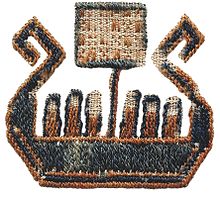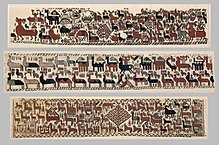Överhogdal tapestries




The Överhogdal tapestries (Swedish: Överhogdalstapeten) are a group of extraordinarily well-preserved textiles dating from the late Viking Age or the Early Middle Ages that were discovered in the village of Överhogdal in Härjedalen, Sweden.[1]
Discovery and dating
The Överhogdal tapestries were found in the vestry of Överhogdal Church (Överhogdals kyrka) in the Diocese of Härnösand by Jonas Holm (1895-1986) in 1909 during the renovation of the church. The tapestries were brought to Östersund in 1910 by the artist Paul Jonze (1883-1973) and the County Governor's wife Ellen Widén, who was a dominant figure within the regional heritage movement at the time, took charge.[2] The first thing she did was to give the dirty linen a good wash.[2][3] Radiocarbon dating tests conducted in 1991 indicated that the tapestries were made between 800 and 1100 AD, during the Viking Era.[4] Newer tests in 2005 instead indicated a period between 1040 and 1170 AD.[5]
Description and construction
The Överhogdal tapestries have been theorized as depicting imagery of both Norse and Christian origin. The contents of the pictures are much debated; some characters have a pagan content, featuring the detailed look of Odin's horse Sleipnir, while other characters are clearly part of Christian imagery. The artwork depict stylized animals, dark blue and red horses, birds and people. There is also a ship, a tree and inscriptions. The four surviving sections of the tapestries have 323 figures of people and 146 and 3 partial animals, all generally moving to the left.[2]
The large animal and smaller human figures seem to rush by a tree, which could be the mighty ash Yggdrasil, a massive tree central to nine worlds in Norse mythology. Some scholars have suggested that what is shown is the Christianization of the region Härjedalen. However, today the dominant theory, given the radiocarbon dating of the tapestries, is that Ragnarök, a series of events foretold to occur in Norse mythology, is being depicted. Research has established that the figures are made of plant dyed wool, which is interwoven with the linen with a special technique.[6]
Today, these unique tapestries are on display in a specially designed room at Jamtli, the regional museum of Jämtland and Härjedalen in Östersund.[7]
See also
References
- ^ "Överhogdal Tapestries". wsimag.com/culture. 17 September 2018. Retrieved August 1, 2019.
- ^ a b c Göransson, Eva-Marie (1995). "Människor i Rum av Id: Bilder av Kvinnor och män på Överhogdal" (PDF). Fornvännen. 90. Swedish National Heritage Board: 129–138. Retrieved 2010-05-03.
- ^ "Paul Jonze". lexikonettamanda. Retrieved August 1, 2019.
- ^ Nordanskog, Gunnar (2006). Föreställd Hedendom: Tidigmedeltida Skandinaviska Kyrkportar i Forskning och Historia. Lund: Nordic Academic Press. p. 255. ISBN 978-91-89116-85-6.
- ^ "'Nya' rön om de gåtfulla vävarna" ["New" findings about the mysterious tapestries]. Länstidningen Östersund (in Swedish). 22 January 2010. Archived from the original on 28 January 2010.
- ^ Kaliff, Anders (1998). "Recensioner" (PDF). Fornvännen. 93. Swedish National Heritage Board: 54–56. Archived from the original (PDF) on 18 July 2011. Retrieved 2 June 2010. (reviewing Wikman, Sture (1996). Fenrisulven Ränner: En Bok om Vävarna från Överhogdal. Jämtland Museum. ISBN 91-7948-118-3.)
- ^ "Överhogdal tapestries at Jamtli". jamtli.com. Retrieved December 1, 2019.
External links
- The Överhogdal Tapestries at Jamtli
Related reading
- Ulla Oscarsson (2010) De gåtfulla Överhogdalsbonaderna(Östersund: Jamtli Förlag) ISBN 9789179482312

